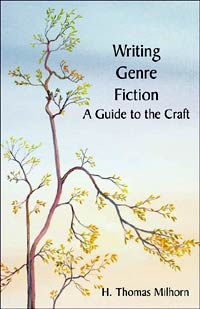|
|
|
CLICK ON A STORE |
|
|
|
Reviews
Good overview "WRITING GENRE FICTION: A GUIDE TO THE CRAFT is one of the most complete guides on writing out there. I've written a number of short stories and taken several writing classes. None of them have delved into infusing your characters with emotion or covered dialogue as extensively. This guide on writing makes a great addition to my reference library."
Other authors Best-selling novelist Robert Dugoni recommended Writing Genre Fiction: A Guide to the Craft as "one of your absolute must-read writing resources." He lists it as "one of the six books every author should have and study." The six books every author must have and study |
Books by H. Thomas Milhorn
|
Writing Genre Fiction: A Guide to the
Craft ISBN #1581129181
Several years ago,
after many years of writing nonfiction, I decided to write a novel—a
medical thriller in the mold of Robin Cook, Michael Crichton, and
Michael Palmer. The problem was that, although I knew how to write
and had received a number of awards for nonfiction works, I didn’t
know how to write fiction. So, before putting fingers to keyboard I
did a thorough search of the literature, which included reading
numerous books and hundreds of website articles. What I discovered
was that there simply wasn’t one good source from which to learn the
craft of writing fiction. My research culminated in the publishing
of my first novel, Caduceus Awry, which was a finalist in the Eudora
Welty Film and Fiction Festival novel writing contest. |
|
Chapter 1.
Key Elements of Genre Fiction - Literary Fiction versus Genre Fiction - Literary Fiction - Genre Fiction - Fiction Length - Key Elements - Plot, Story, and Structure - Setting - Characters - Point of View - Prose - Theme and Subject Chapter 2. Choosing your Genre - Action/Adventure - Christian - Fantasy - Light Fantasy - Arthurian Legend - Heroic Fantasy - Gay/Lesbian - Historical - Horror - Mystery/Detective - The Amateur Detective - The Cozy - The Police Procedural - The Private Detective - The Puzzle - Romance - Contemporary - Gothic - Regency - Other Subgenres - Science Fiction - Apocalyptic/Post-apocalyptic - Cyberpunk - First Contact - Hard - Military - Soft/Sociological - Space Opera - Time Travel - Spy/Espionage - Thriller - Medical Thriller - Legal Thriller - Technothriller - Western - Young Adult Chapter 3. Backstory to Description - Backstory - Direct Methods - Indirect Methods - Backstory Length - Clichés - Cliché Phrases - Cliché Characters - Cliché Situations - Description - Blending Description - Brand Names - The Words to Use Chapter 4. Figurative Language to Introspection, Insight, & Perception - Figurative Language - Painting Mental Pictures - Substituting Words for Sounds - Other Functions - Foreshadowing and Flash Forward - Foreshadowing - Flash Forward - Form and Structure - Form - Structure - Imagery - Levels of Imagery - Suggestions for Using Imagery - Information - Interlocking Episodes - Introspection, Insight, and Perception - Introspection - Insight - Perception Chapter 5. Linking Episodes to Series - Novels - Linking Episodes - Modifiers - Adjectives - Adverbs - Valueless Modifiers - Narrative - Point of View - First-person Point of View - Third-person Point of view - Multiple Points of View - Second-person Point of View - Sentences - Sentence Fragments - Sentence Variety - Series Novels
Chapter
6. Setting to Special Scenes |
- Beginning |
